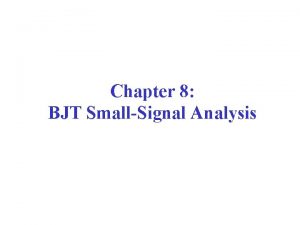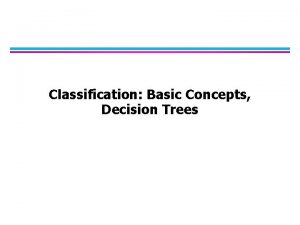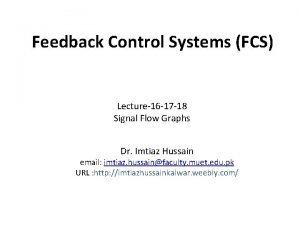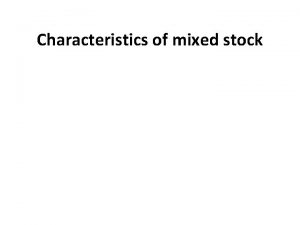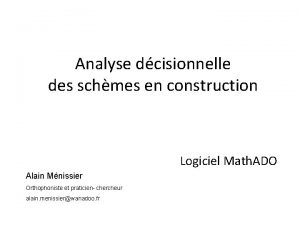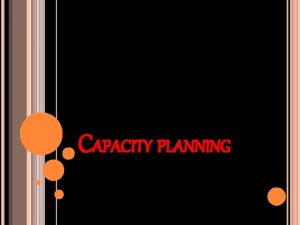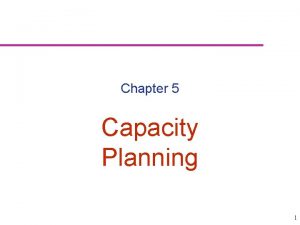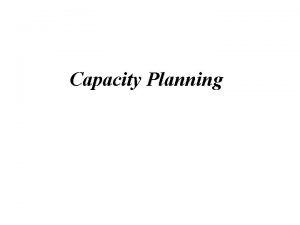1 Capacity Gain of Mixed MulticastUnicast Transport Schmes






















- Slides: 22

1 Capacity Gain of Mixed Multicast/Unicast Transport Schmes in a TV Distribution Network Zlatka Avramova, Student Member, IEEE, Danny De Vleeschauwer, Sabine Wittevrongel, and Herwig Bruneel July , 17, 2009 2021/10/17

2 2021/10/17 Outline • Introduction • Channel popularity probability distribution and Modeling User Behavior • Two proposed Mixed Multicast/Unicast Deployment Strategies • three approaches to estimate the resource demand • choose the optimal number of channels to be multicast in the static scenario • Compare Capacity gain in the two scenario • application examples • Conclusion

3 2021/10/17 Introduction • Cable TV => IPTV=> increase demand of resource Triggered the development of broadcast/unicast technology • Static & Dynamic Scenario Discussing combined broadcast/unicast to savings on network resource • Proposed three approach: 1. Exact Approach 2. Gaussian Approximation 3. Sumulation Tool • Calculate & compare with the diagram

4 2021/10/17 Channel Popularity Probability Distribution And Modeling User Behavior • k = channel’s rank • d = constant • Heavy tailed • a= active rate (the one add here) • K=0 user is passive

5 2021/10/17 Two Proposed Mixed Multicast/Unicast Deployment Strategies • P (block): the blocking popularity • β: Multicast bandwidth/Unicast bandwidth (rarely >3) • Static Scenario: multicasts constantly M most popular channels unicast on request • Dynamic Scenario: the transport mode can change frequently according to the number of user

6 2021/10/17 Three Approaches To Estimate The Resource Demand 1. Exact Approach: • A. Static Scenario: Process: Result:

7 2021/10/17 Three Approaches To Estimate The Resource Demand • B. Dynamic scenario (Random variable)

8 2021/10/17 Three Approaches To Estimate The Resource Demand • 2. Approximation with the normal distribution • A. Static Scenario: • V[nu]: B. Dynamix Scenario

9 2021/10/17 Three Approaches To Estimate The Resource Demand 3. Simulation Tool • Use language C • Parameter: a= active rate πk=probability of channel k is selected Pblock&Rs&Rd

10 2021/10/17 Comparison Of The Three Approach • A. Gaussian approximation V. S. Exact Calculation • In the two Scenario • In the different Numbers of sample Result: Gaussian is Better!!!!(efficient)

11 2021/10/17 Comparison Of The Three Approach • B. Simulation V. S. Gaussian big sample small sample

12 2021/10/17 Choose the optimal numbers of channels to multicast in static scenario • With different M K=100, a=0. 7, α=0. 9, β=1 N=200 •

13 2021/10/17 Superiority Of The Dynamic Scenario And Definition Of Capacity Gain • Proof in calculation • definition • result

14 2021/10/17 Superiority Of The Dynamic Scenario And Definition Of Capacity Gain • Illustration:

15 2021/10/17 Superiority of the Dynamic scenario and Definition of Capacity Gain • Definition of Capacity Gain Zipf distribution •

16 2021/10/17 Capacity Demand Over One Day • 96 measurements per day

17 2021/10/17 Influence Of The Model Parameters On The Capacity Demand • Increasing number of users

18 2021/10/17 Influence Of The Model Parameters On The Capacity Demand • Influence Of β:

19 2021/10/17 Application Examples u. Hybrid fiber-coax(HFC)TV • MPEG-2 • QAM • Has a return channel

20 2021/10/17 Application Examples u. The mobile TV network l. DVB-H l. UMTS spectrum

21 2021/10/17 Conclusion • Measurement: Gaussian is better • Dynamic scenario • The capacity demand in a given day

23 2021/10/17 How do Wi. Max support multicast on base station ICS(Intermediate Control Server)
 Production units have an optimal rate of output where
Production units have an optimal rate of output where Active transport image
Active transport image Primary vs secondary active transport
Primary vs secondary active transport Pinocytosis vs phagocytosis
Pinocytosis vs phagocytosis Bioflix membrane transport
Bioflix membrane transport Primary active transport and secondary active transport
Primary active transport and secondary active transport Primary active transport vs secondary active transport
Primary active transport vs secondary active transport Now answer the questions
Now answer the questions Bioflix activity membrane transport active transport
Bioflix activity membrane transport active transport Passive transport vs active transport venn diagram
Passive transport vs active transport venn diagram Information gain
Information gain James gain
James gain Common mode rejection ratio
Common mode rejection ratio To gain familiarity with a phenomenon
To gain familiarity with a phenomenon Amplifier circuit
Amplifier circuit Bjt re formula
Bjt re formula Gain ratio
Gain ratio Information gain
Information gain How to make parents trust you
How to make parents trust you Forward path gain
Forward path gain Gain on bargain purchase
Gain on bargain purchase Information gain feature selection
Information gain feature selection How would iago gain from roderigo's death cassio's
How would iago gain from roderigo's death cassio's















